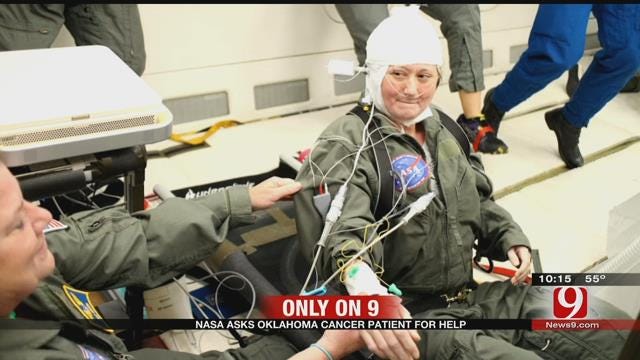Oklahoma Cancer Patient Flies Into Zero Gravity
<p>Astronauts traveling in space have come home with vision problems. So, researchers conducted a study to find out why, using an Oklahoma cancer patient, a microgravity plane and a trip out of this world.</p>Wednesday, March 16th 2016, 10:45 pm
Astronauts traveling in space have come home with vision problems.
So, researchers conducted a study to find out why, using an Oklahoma cancer patient, a microgravity plane and a trip out of this world.
"It was hard, very hard," said Cherri Pepper-Holman, of Pauls Valley.
"I went to the hospital thinking 'oh, it's a head cold' not thinking cancer by any means."
She had acute lymphoblast leukemia. Through port inside her brain, called an Ommaya, she received eight rounds of chemotherapy, beating her cancer into remission, but her journey didn't end there.
"I was like 'wow, this is something that not very many people get picked to do,'" she said.
Dr. Benjamin Levine, professor of cardiology and Director of the Institute for Exercise and Environmental Medicine at UT Southwestern Medical Center and Texas Health Resources, needed eight cancer patient volunteers with working Ommayas for his latest study with NASA.
"I harkened back to my residency days working with leukemia patients and remembered that some patients have these ports - they're called Ommaya reservoirs - placed to deliver chemotherapy to cancer microcells in the brain," Levine said. "It was quite challenging to find just the right people. I probably sent 1,000 emails around the country."
He found Pepper-Holman and seven others with working Ommayas and willing to participate in the study. During a recent trip to UT Southwestern Medical Center in Dallas, Levine explained what's happening to some astronauts during long duration space flights.
"The shape of the eye changes, the globe gets flatter, looks like it's being pushed in from behind," he explained. "It's kind of like if you have an area rug and take a running leap and it kind of folds up, it's called choroidal folds."
These changes are causing some astronauts to lose their vision. To find out why, Levine prepared Pepper-Holman and the others for a trip into weightlessness aboard NASA's C-9 plane. Strapped down Pepper-Holman felt the thrill of microgravity as the plane climbed to 34,000 feet, then dipped back down to 26,000 feet. During the 40 intervals of weightlessness, researchers recorded the pressure inside their brains through their Ommayas.
"This is, in a healthy human being, the best method of measuring intracranial pressure on the planet," said Dr. Justin Lawley, one of the researchers on board during the flight.
Considered a success, the flight didn't give them the results they thought.
"What they thought was actually going to zero G with gravity removed, all that fluid would move up and then cause that congestion in the head and increase intracranial pressure," Lawley said. "What actually happened was the pressure went down, so it's the exact opposite of what we thought would be true."
Instead, researchers now believe it's the constant weightlessness that is causing some astronauts eyes to change.
"What we think is the pressure is a little bit higher when you are upright but lower than supine but since you can't stand up in space you're body never gets the chance to unload, the brain never gets a chance to relax," Levine said. "They were critical findings because now we've got a way to fix it."
Levine said they are now working on a sleep sack for astronauts to wear while in space.
"The body needs a chance to rest and that's what we want to do we want to rest the brain at night by sucking blood back into the feet," Levine said.
For Pepper-Holman, after a year of fighting for her life, she finally found a higher purpose.
"This whole thing with this cancer, it's a depression kind of thing," said Pepper-Holman. "It was something for me to look back on to think about that I had fun doing. I really believe everything happens for a reason and it happened for a reason for me, maybe this is my way of giving back for everyone that has given to me, just passing it along."
Pepper-Holman is recovering from a stem cell transplant in her fight to stay cancer free. Meanwhile, clothing company Under Armour is working on a sleep sack for researchers to use in their next microgravity study.
More Like This
March 16th, 2016
March 22nd, 2024
March 14th, 2024
February 9th, 2024
Top Headlines
April 26th, 2024
April 26th, 2024
April 26th, 2024
April 26th, 2024










